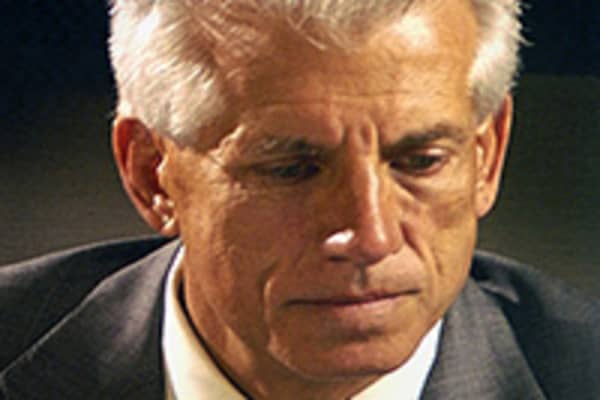The case of Allen Stanford, a former billionaire who once allegedly sealed a deal with blood and is currently serving a 110-year federal prison sentence, could soon be back in the headlines. A federal judge ruled last month that investors could proceed with a lawsuit that alleges the Securities and Exchange Commission (SEC) was negligent in its handling of the fraud.
Texas-born Robert Allen Stanford exuded wealth. At his height in 2008, he was one of the richest men in America, listed on the Forbes 400, and worth an estimated $2.2 billion.
Watch “American Greed” to see how Stanford went from Scuba Diving instructor to International Banker.
He defined conspicuous consumption. In one three year period alone, he spent $100 million on aircraft, which included helicopters and private Lear Jets. He even spent $12 million lengthening his yacht by just 6 feet.
As it happened, however, Stanford indulged in these perks with ill-gotten gains. In early 2009, the scale and scope of Stanford’s extravagances finally caught up to him.
Stanford was eventually convicted of selling fraudulent certificates of deposit from his offshore bank on the island of Antigua in an international $7 billion Ponzi scheme, a case that drew comparisons to disgraced broker Bernie Madoff’s multibillion dollar fraud. To date, none of the more than 20,000 investors he bilked have recovered any money.
In their lawsuit, the investors claim that on four instances and as early as 1997, the SEC determined that Stanford was running a Ponzi scheme. Still, the agency did not act accordingly and failed to notify the Securities Investor Protection Corporation. Investigators did not bring charges against Stanford until 2009, in the wake of the global financial crisis.
The government moved to dismiss the case, but U.S. District Judge Robert Scola rejected the motion. He ruled that if the SEC knew Stanford was running a Ponzi scheme as alleged by plaintiffs, the agency was obligated to report it. Scola added that the government could argue that it did not know Stanford was running a fraud if and when the case moved to summary judgment.
SEC spokesman John Nester declined to comment to “American Greed.” Nonetheless, the attorney for the investors, Gaytri Kachroo, said the ruling was significant. “It truly provides the investing public a precedent and therefore the hope that a case against the SEC can succeed if meritorious under the law,” the lawyer said.
A Conman’s Bogus Empire of Epic Proportions
Beyond fancy toys, Stanford bought a small island for $63 million. He owned mansions in Houston, Antigua, and St. Croix. And in Coral Gables, Fla. an enormous 18,000 square foot castle. It was fit for a king: the property included 57 rooms, a tower and a moat. Yet after just one year of living there, he grew tired of the sprawling estate — moving out and having it demolished.
He also loved the game of cricket. By 2008, he was considered the world’s number one promoter of the sport, even offering up a $20 million cash prize, the largest ever for a team sporting event, for a match in London.
Yet according to the U.S. Attorney’s office, Stanford was not playing with honest money. He got it by siphoning off loans to himself, approximately $2.2 billion from depositor’s CD holdings, without ever revealing these loans to investors.
From Brash Texan to Big Money Banker
Stanford grew up in a small town 90 miles south of Dallas. Much like his home-state, everything about the man was Texas-sized.
Doug Birdsong, who used to workout with Stanford, recalled him as a muscular man, standing 6’5” and weighing about 330 pounds. “He was the biggest, he was the best, and he was the boss,” Birdsong told “American Greed.”
His early business ventures ended in failure. After losing a string of health clubs to bankruptcy in 1982 and racking up $13 million in personal debt, Stanford took a few more stabs at entrepreneurship before heading to the Caribbean, where he first entered banking.
He founded “Stanford International Bank” in 1991 on Antigua. It was there that he laid the foundation of his empire, becoming the island’s largest employer.
He targeted wealthy Latin Americans worried about the stability of their governments, and it worked. Within three years, the bank’s assets skyrocketed to $350 million.
One year later, he moved into the U.S. market, establishing Stanford Financial Group in Houston. The company became known for selling certificate of deposits (CDs). Synonymous with safety, CDs seemed like a smart choice for potential buyers. As Stanford’s investors piled into these instruments, in less than a decade the group grew to $3 billion.
Unwitting investors, however, had no idea that Stanford’s CDs were anything but safe.
A Scam from the Start
Yet suspicions rose in 2005 when SEC investigators began taking a hard look at Stanford Financial Group, specifically his Certificates of Deposit from Antigua. Three years later, when two whistleblowers came forward, the agency was handed hard proof of Stanford’s fraud.
Assistant U.S. Attorney Paul Pelletier got the case from the SEC. He landed a huge break when Jim Davis — Stanford’s right-hand man since the 1980’s and the company’s chief financial officer – agreed to talk in exchange for a reduced sentence.
Davis confessed that from his first day on the job, the company simply made up numbers and cooked the books. “That’s what his job was as CFO, and he continued to do that from 1987 or ’88 all the way until 2009,” Pelletier said.
When they first started the business, Davis said Stanford could do whatever he wanted on Antigua. He had the island’s chief banking regulator in his back pocket. In a bizarre twist, the two even sealed a bribery scheme deal by becoming “blood brothers,” cutting their fingers to mix their blood, according to Davis.
A decade-and-a-half after Stanford Financial Group first opened its Houston headquarters, the SEC shut its U.S. operations down. In June 2009, Stanford was mired in charges of fraud, conspiracy to launder money and conspiracy to obstruct justice.
Throughout his trial, however, the former high-flying billionaire steadfastly maintained his innocence. He attempted to put the blame on Davis, but a jury did not buy his story. This March, he was found guilty on 13 counts, and later sentenced to more than a century in prison.
Investors Devastated by Economic Homicide
Many of the investors at the sentencing were satisfied, with Sandra Dorrell being one of them.
In 2005, after selling off an office furniture business, she invested her money in the Stanford Group’s CDs. A single mother who was battling a rare, life-threatening condition called Caroli’s disease, she had planned to use her investment to give her peace of mind and financial security as she endured medical treatment.
Instead, she lost every penny.
Hear how Sandra Dorrell’s broker sold her $1.3 million in fraudulent CD’s.
“To lose $1.3 million to someone that absolutely stole the money from me is just horrific,” Dorrell told CNBC’s “American Greed.”
Fellow investor Cassie Wilkinson, who along with her husband lost six-figures to Stanford’s treachery, agreed.
“The sentencing for crimes like this has become so big and so long that they’re comparing it to economic homicide, and really, that’s what it is,” she said. “Someone murdered the life that I knew, that I worked hard for. We were not born with money; we earned every single penny,” Wilkinson added.
For 62-year-old Stanford, a projected release date of 2105 is a life sentence –one that he deserves, according to many of his victims.
Tune in:
Watch American Greed
Wednesday October 10th at 10 P.M. EDT/PT on CNBC.






